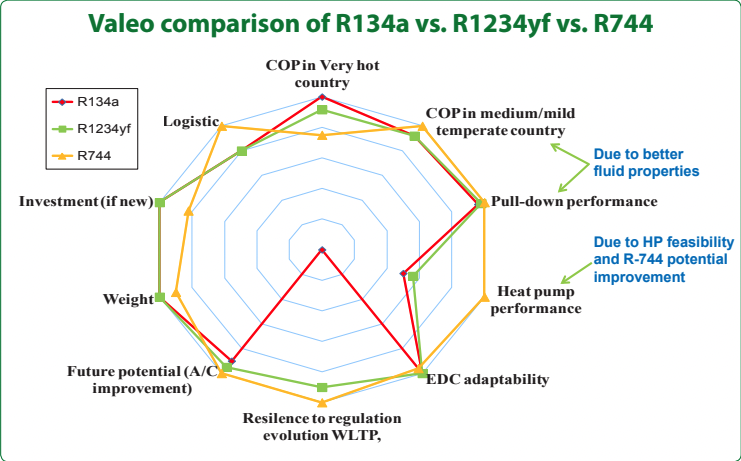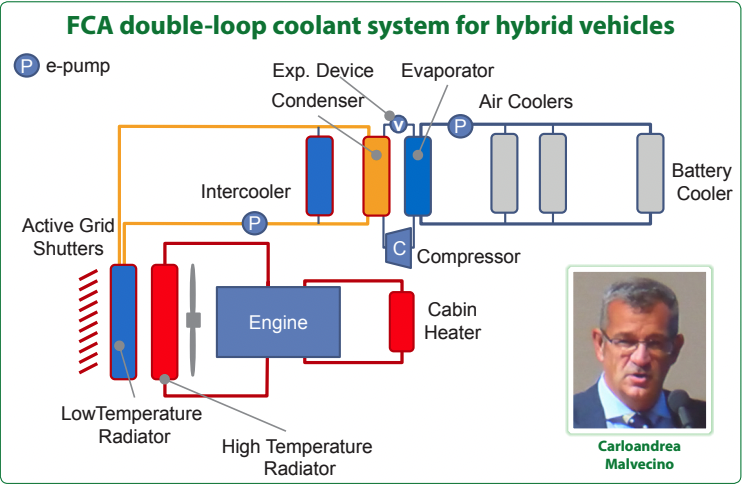Will R744 dominate auto-AC?
- PostedPublished 13 October 2017
THE first vehicles with air-conditioning systems using R744 (carbon dioxide) refrigerant are rolling off European production lines and special equipment for servicing them has hit the market, heralding the dawn of a multi-refrigerant era.
At a time of industry consolidation and rapid increases in platform, technology and component sharing between automotive manufacturers, this fork in the roads over air-conditioning technology can only end with one winner.
Right now, the industry cannot agree. In one camp R1234yf is seen as a stepping-stone solution that will inevitably be superseded by R744. Others see insurmountable challenges with the automotive application of R744 and expect R1234yf to prevail. Some see the pursuit of R744 as foolish and wish the whole industry would just stick with R1234yf and provide everyone with some much-needed certainty.

SightGlass News canvassed the above opinions from a broad range of component OEMs, system designers, equipment manufacturers, engineers and other industry figures at the September 2016 Automechanika expo and European Automotive Air-Conditioning Convention (EAAC) in Frankfurt.
One area of apparent consensus is that R744 is will play an important role in heat pump systems that will regulate battery temperatures and provide energy-efficient cabin comfort for electrified vehicles, particularly at very low ambients.
If the long-term future of mobility centres on electric drivetrains, the use of two different refrigerants in one vehicle seems illogical compared with, for example, running a reverse-cycle air-conditioning system.
According to management consultants IHS Markit, R1234yf currently adds around €50 ($A72) to the cost of a vehicle due to the high refrigerant price and the addition of an internal heat exchanger component.
While charge weights are reducing to combat part of the cost, for some factories there is also the complexity of running R134a cars down the same lines for export markets that are not ready for YF, or more to the point, where legislation does not yet require it.
An R744 system is around €300 more expensive than the R134a or R1234yf equivalent, but the refrigerant is much cheaper. The system cost will reduce over time, but how quickly that happens is a chicken-and-egg situation depending on uptake.
IHS Markit predicts R744 uptake to get going from around 2021, with just under 10 million cars using CO2 refrigerant worldwide by 2025. However, R1234yf’s head start will mean more than six times as many vehicles will be using the synthetic refrigerant by then.
North American YF uptake is predicted to peak in 2021, with Europe peaking two years later. IHS Markit forecasts and analysis director David Smith-Tilley told SightGlass News this represented “the expected adoption of CO2” in those regions (see graphs on page 4).
SightGlass News understands cars using R744 will be restricted to Europe at first, where the performance and reliability can be more easily assessed by their manufacturers.
However, United States based SAE International this year reopened a set of mothballed standards relating to vehicles using this refrigerant. English translations of German DIN standards relating to R744 are also being made available to SAE.
This is a sure sign the world is getting ready for automotive R744, as the SAE standards would ease the international export of vehicles using this refrigerant, and the required service equipment.
Significant research into automotive R744 applications took off in the early 2000s, with trials on vehicles from General Motors, Nissan, Mercedes-Benz, Volkswagen Group and others.

One early study converted a US Army armoured Humvee from the vehicle’s rather old-school standard R134a installation to CO2, with the goal of producing a solution viable for the harsh desert conditions of Iraq.
The conversion was considered a success, with the prototype R744 setup weighing less, taking up less space, cooling the Humvee’s cabin quickly and keeping it cooler – even in 49 degree ambients – than the R134a system it replaced.
At least two more international studies have shown R744 systems to have lower impact on fuel consumption in passenger cars than those using R134a, particularly in temperate climates.
Concerns about CO2’s relevance to hot climates such as Australia appear to be quashed, but only real-world experience will tell the true story.
Valeo director of research, development and product marketing Mark Sondermann told SightGlass News R744 has some performance advantages for operating in high-ambient conditions.
“The nice thing for Australia is, the quick time to cool down – today in some conditions you have to wait for up to one minute to really feel the cool air coming (from the vents),” he said.
“This minute is what you can save (with R744), it cools down faster. It is cooling down faster because we have more power, but more power means more energy. Once it stabilises out, I think there is no big (efficiency) difference finally between R744 and R1234yf.”
Mr Sondermann went on to explain that R744 efficiency would be slightly lower than YF at slow road speeds, but that with ram air over the gas cooler (which R744 systems use instead of a condenser) there would be little comparison.
“The power is higher, the efficiency is getting slightly worse especially in idle, but if you are not idling you will get an equivalent performance, minimum.
You will not really be able to measure this,” he said.

Mr Sondermann showed the EAAC audience a graph demonstrating the improved cool-down performance of R744 compared with R134a, although it is slightly less efficient at maintaining head and vent temperatures due to the gas cooler being more sensitive to high ambient conditions than a condenser.
Above 35 degrees ambient, R744 efficiency starts to suffer compared with R1234yf and R134a.
“At that 35 degree point R1234yf becomes more efficient because the amount of energy we put into R1234yf to get the same power is less,” Mr Sondermann told SightGlass News.
Like R134a and R1234yf, belt-driven compressors are used for R744 cars with combustion engines, while those with hybrid and electric drivetrains have direct-drive electric pumps.
The heat pump advantage
Peering into the future, a lot of research and development work is happening with heat pumps for electrified vehicles.
Markus Boger from the pre-development air-conditioning department of component supplier Mahle told EAAC delegates a compact electric car such as a Nissan Leaf can lose around 40 per cent of its battery range while using a high-voltage resistive heater, compared with a 17 per cent range reduction when using an R1234yf heat pump.
He explained that battery thermal management and cabin comfort are linked because batteries work best between 20 and 40 degrees Celsius, with premature aging likely when charged or used outside this range.
Future electric vehicle technology will require higher battery capacity and faster charging, with electric trucks and range-extenders using on-board generators becoming commonplace. All require more heat to be transferred in shorter periods of time – and Mr Boger said heat pumps would play a vital role in this evolution.
Mr Sondermann also spoke about heat pumps, referring to a Tesla test bed in which an R744 heat pump extended battery range by between 20km and 50km at ambient temperatures below -10 degrees.
He said that in general, R744 heat pumps use almost half the energy of the YF equivalent between -10 and -25 degrees. R744 also has better heating performance at lower temperatures (R1234yf cannot operate below -25 degrees) but their performance is around the same once ambient temperatures reach zero.

Compared with resistive electric heaters, which also need dehumidification to prevent misting, Mr Sondermann said heat pumps could increase battery range by 65 per cent in winter and 40 per cent in summer.
Fiat Chrysler Automobiles (FCA) Italy director of CO2 emission reduction strategies Carloandrea Malvecino explained at EAAC that the more vehicles rely on electrified drivetrains, the less heat will be available for cabin comfort because combustion engines will spend more time switched off, or omitted altogether.
For this reason, thermal management will become critical to improving efficiency, maximising driving range and ensuring vehicle occupants are comfortable.
A reverse-cycle air-conditioner, running R744, sounds like a compelling solution as it can efficiently heat, cool and dehumidify whether in the Arctic Circle or the Simpson Desert.
Interference
In 2004 component supplier Valeo announced that the first production cars to use R744 would reach the market by 2009.
But as R1234yf can use similar compressors and heat exchangers as R134a, it emerged as the easy option and CO2 development petered out until Mercedes-Benz parent company Daimler famously took issue with YF’s flammability in 2013.
This prompted the current R744 renaissance that Mr Smith-Tilley described as ”interference” creating uncertainty over the long-term future of YF.

A senior figure from a tier-one automotive supplier told SightGlass News he thought R744 was “a lunatic path” and lamented the lack of market certainty introduced by some manufacturers persisting with CO2 when the majority were happy with R1234yf.
Concern over the high operating pressures of R744 making refrigerant leaks more likely was raised by another industry figure. From an environmental perspective this is less troublesome than R134a but it is still inconvenient for vehicle owners who would require regular repairs or refrigerant top-ups.
However, the consensus at Automechanika Frankfurt and EAAC was that R744 has a bright future. At the very least, it will exist in parallel with R1234yf and looks to be the refrigerant of choice for heat pumps in electrified vehicles.
Of course, R134a will remain available to service existing equipment, so workshops must get used to handling three factory-spec refrigerants, two system architectures, the advent of heat pumps and contamination from hydrocarbon retrofits.
- CategoriesIn SightGlass
- TagsSightGlass News Issue 8

